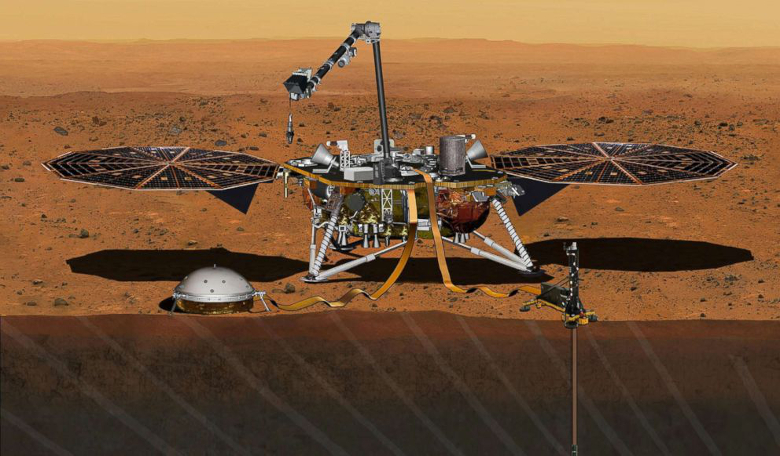At the 50th Lunar and Planetary Science Conference held in Houston, Texas this week, scientists working on NASA’s InSight mission reveal Mars’s interior is not only proving to be somewhat quiet, so far, but that its surface is plagued by ‘dustless devils’ that sweep over the martian surface up to 14 times a day.
Since it landed on the Red Planet over three months ago, InSight has been busy collecting data from its suite of instruments, all of which are designed to give the most thorough examination yet of our nearest planetary neighbour.
Already firmly planted on the ground and hidden under a protective heat shield is InSights’ Seismic Experiment for Interior Structure (SEIS) instrument. SEIS’s main role is to listen out for ‘marsquakes;’ pulses or seismic vibrations that rattle through the planet’s interior revealing clues as to how the Red Planet is made up. So far though, the sensitive listening apparatus has yet to record any internal rumblings, says Bill Banerdt who works on the InSight mission. Still, it is very early days notes Banerdt and there are no set expectations as to when these things might strike.
Speaking of striking or rather hammering, InSight’s heat flow probe, HP3, has also hit a snag, or rock perhaps reports Banerdt. The jack-like device which is designed to channel out a hole ready for a mole to descend deep and measure Mar’s internal temperature, has come to a halt about 50 centimetres under the ground.
It is not clear yet whether the obstructing object is a large rock or a harder stratigraphic layer, and despite two attempts at trying to bypass the obstacle the team haven't given up on getting the mole down to a depth of five metres as per the original plans. If the probe still won't budge after the next try however, then it might require a radical solution to find a way forward say the InSight team.
Meanwhile, back on the surface, monitoring the temperature and endlessly blowing wind is TWINS. TWINS, which stands for Temperature and Winds for InSight, is part of a round-the-clock weather station called the Auxiliary Payload Sensor Suite (APSS) that is strapped to both sides of the lander. This collection of tools records data every second of every sol (a Martian day) and then sends the information back to Earth on a daily basis.
Up until recently, TWINS had been recording daily occurrences of vortices – swirling whirlwinds devoid of dust or ‘dustless devils’ – that were whizzing past InSight frequently throughout the martian day. However after a dust storm blew through on sol 42, the dustless devils have dropped to around six per day.
These are just preliminary results and any long term weather patterns have yet to be established, but as InSight's primary mission is two Earth years, or a little over one Mars year, there is still a lot to be learned about our martian neighbour.











